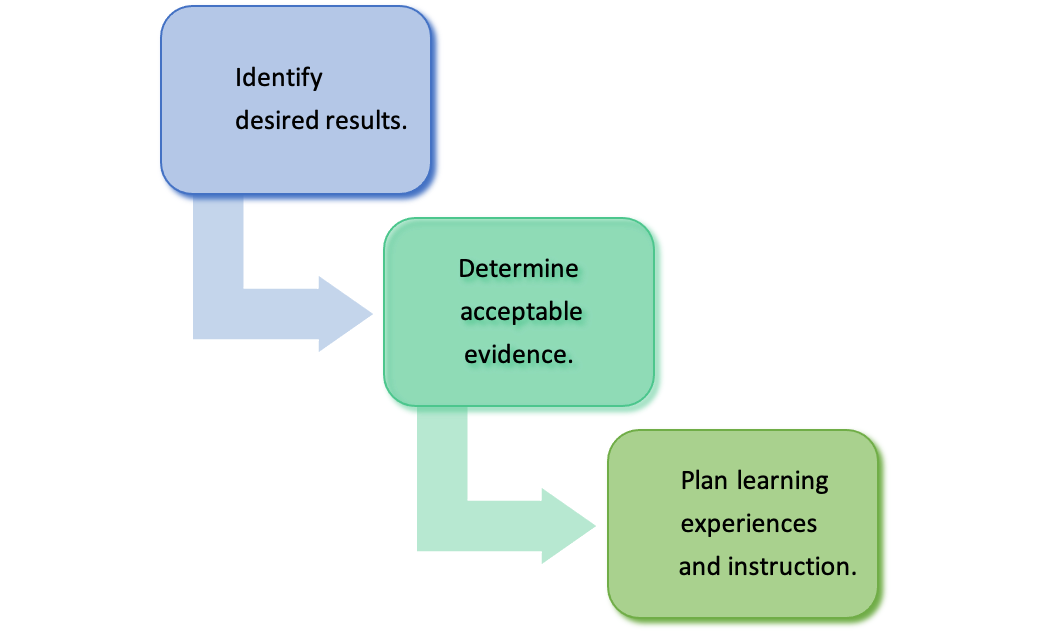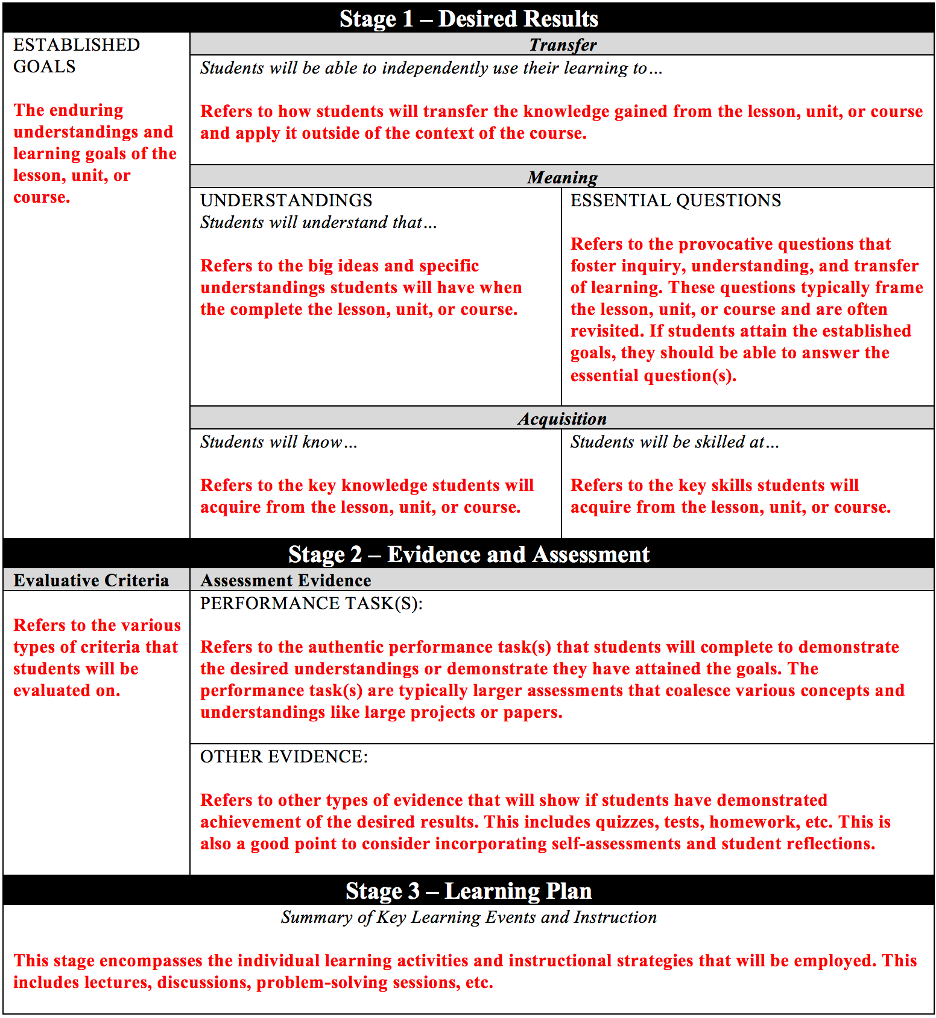10 Backward Design Process as a Curriculum Development Model
“To begin with the end in mind means to start with a clear understanding of your destination. It means to know where you’re going so that you better understand where you are now so that the steps you take are always in the right direction.” —Stephen R. Covey
Introduction
The essential question in all curriculum planning is: what should students know and be able to do as a result of the lesson or learning? Since national, state, and local standards often guide the work of teachers and curriculum developers, they serve as a framework to help prioritize the “learning targets.” It is traditional to begin with the frontloading design which puts the standards first, but in an age of high-stakes testing, many districts are looking at how to match curriculum with state and district testing requirements.
Backward design, or the backloading of curriculum, is often used when the traditional frontloading of curriculum is not practical. Why is this? Frontloading becomes impractical when state or local districts adopt assessments that do not reveal the content of what is tested. This is most often the case with assessments that are published by corporations whose goal is to maintain a “normal curve” with a few students having high scores, with most students scoring in the middle, and some having low scores. This is in contrast to schools and teachers who want to have as many students as possible attain high scores.
To help solve this problem, curriculum developers attempt to match the contents of the local or state curriculum, which are based on the standards, to the test or tests using backward design. Districts often begin with the test items that were released as a starting point in the process. A more in-depth description of this process follows.
Essential Questions
- How is backward design different than traditional curriculum design?
- What are the main elements of the Backward Design model?
- How is the Backward Design model similar to English’s Aligned Curriculum? How are they different?
- Why isn’t backward design used in all curriculum design processes?
Backward Design
From Vanderbilt University Center for Teaching, Understanding by Design.
Understanding By Design, a text written by Grant Wiggins and Jay McTighe, offers a framework for designing courses and content units called “Backward Design.” Instructors typically approach course design in a forward design manner, meaning they consider the learning activities (how to teach the content), develop assessments around their learning activities, then attempt to draw connections to the learning goals of the course. In contrast, the backward design approach has instructors consider the learning goals of the course first. These learning goals embody the knowledge and skills instructors want their students to have learned when they leave the course. Once the learning goals have been established, the second stage involves consideration of assessment. The backward design framework suggests that instructors should consider these overarching learning goals and how students will be assessed before consideration of how to teach the content. For this reason, backward design is considered a much more intentional approach to course design than traditional methods of design.
The Three Stages of Backward Design
“Deliberate and focused instructional design requires us as teachers and curriculum writers to make an important shift in our thinking about the nature of our job. The shift involves thinking a great deal, first, about the specific learnings sought, and the evidence of such learnings, before thinking about what we, as the teacher, will do or provide in teaching and learning activities.” — Grant Wiggins, Understanding by Design

UbD Resources
The blank backward design template is referred to as UbD Template 2.0. The older version (version 1.0) can also be downloaded at the Jay McTighe site previously mentioned, as well as other resources relevant to Understanding by Design. The template walks individuals through the three stages of backward design.
The following template shows how curriculum is developed, with an eye to “Desired Results” which can be translated to test scores.

ILA 10.0
- Use the UbD Template 2.0 to apply the Backward Design model to one of your favorite units or lessons.
- Post a brief response to the following question in the ILA Response Group: Did you find the backward design process beneficial? Why or why not?
Benefits of Backward Design
“Our lessons, units, and courses should be logically inferred from the results sought, not derived from the methods, books, and activities with which we are most comfortable. Curriculum should lay out the most effective ways of achieving specific results… in short, the best designs derive backward from the learnings sought.”
In Understanding by Design, Wiggins and McTighe argue that backward design is focused primarily on student learning and understanding. When teachers are designing lessons, units, or courses, they often focus on the activities and instruction rather than the outputs of the instruction. Therefore, it can be stated that teachers often focus more on teaching rather than learning. This perspective can lead to the misconception that learning is the activity when, in fact, learning is derived from a careful consideration of the meaning of the activity.
As previously stated, backward design is beneficial to instructors because it innately encourages intentionality during the design process. It continually encourages the instructor to establish the purpose of doing something before implementing it into the curriculum. Therefore, backward design is an effective way of guiding instruction and designing lessons, units, and courses. Once the learning goals, or desired results, have been identified, instructors have an easier time developing assessments and instruction around grounded learning outcomes.
The incorporation of backward design also lends itself to transparent and explicit instruction. If the teacher has explicitly defined the learning goals of the course, then they have a better idea of what they want the students to get out of learning activities. Furthermore, if done thoroughly, it eliminates the possibility of doing certain activities and tasks for the sake of doing them. Every task and piece of instruction has a purpose that fits in with the overarching goals and goals of the course.
As the quote below highlights, teaching is not just about engaging students in the content. It is also about ensuring students have the resources necessary to understand. Student learning and understanding can be gauged more accurately through a backward design approach since it leverages what students will need to know and understand during the design process to progress.
“In teaching students for understanding, we must grasp the key idea that we are coaches of their ability to play the ‘game’ of performing with understanding, not tellers of our understanding to them on the sidelines,” (Wiggins and McTighe, 1998).

The preceding content from the Vanderbilt Center for Teaching site is licensed under a Creative Commons Attribution-NonCommercial 4.0 International License.
In the following video, Dr. Stephanie Chasteen and others from the University of Colorado Boulder introduce the concept of backward design with some specific examples of how it can be used in developing curriculum for STEM courses.
Backward Design as a Curriculum-Development Model
Neither backward design nor “frontloading” the curriculum is better than the other. It just depends. The real questions are: where, as a teacher or a committee, do you want to begin? What are the priorities?
The traditional “frontloading” approach begins with the aims, goals, and objectives as a basis for writing of the curriculum, then developing learning activities and assessments (formative and summative) to assess the curriculum. With the backward design, the teacher or curriculum committee either develops the assessments or relies on evidence from commercial assessments or released items from state tests as a beginning point.
A key question here is: what is the evidence that students have met the standards? (i.e., attained the prescribed knowledge and skills to plan the teaching and learning activities). This encourages teachers to “think like an assessor,” according to Wiggins and McTighe. The challenge is that commercial testing companies that develop state tests do not want the most, let alone all the items, known because they fear it would invalidate the test. Experts like Fenwick English argue that if teachers and curriculum committees had more knowledge about what the commercial tests are actually assessing (not specifically individual test items) it would help to create better alignment between what is written, what is taught, and what is tested. This alignment, as we learned earlier, can be helpful to all students, especially students from homes of poverty where there is a paucity of books and reading materials. Unfortunately, most testing companies do not share much of this information, and the released items tend to be those that they will not use again.
Backward design works best when the school or district develops its own tests so they know what the targets are. Even without the knowledge of what is on the tests, most districts tend to favor backward design or backloading because there is great pressure from the stakeholders for students to attain high test scores. In private schools, where high-stakes testing is not as much of an issue, curriculum development is most often frontloaded, particularly with classical education where the aims, goals, and objectives are of primary importance.
Insight 10.0
There is no single “best way” to develop a curriculum. The most important decision for a curriculum committee to make regarding which design to use should be based on what is most appropriate for the school or district.
Summary
Traditional or “frontloading” and backwards or “backloading” design models are used to create curriculum, and both have benefits. In schools or districts where aims, goals and objectives are the focus, the traditional model is probably the best choice. In many districts, backwards design is used because there is an expectation that students should attain high test scores.

